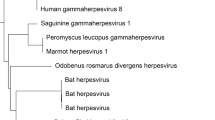Abstract
DNA sequences coding for infectious C-type viruses (oncornaviruses) are present in the genome of normal cells of various species, those best characterised being chicken, mouse, cat and baboon1. Mammalian endogenous viruses, in general, are restricted for growth in their autologous species but replicate in autologous species and are termed xenotropic2. In mice and some other species a further class of endogenous viruses has evolved which is restricted in heterologous cells but replicates in homologous cells, they are termed ecotropic3. Endogenous viral genes are inherited in the germ line and have co-evolved, in general, with non-viral host genes as indicated by evolutionary data4. One explanation for the retention of these genes is that they are involved in physiological functions as proposed by Temin in his protovirus hypothesis5. We have shown previously that B-cell proliferation induced by certain B-cell mitogens is frequently associated with expression of endogenous virus6–10. This has been confirmed by other workers who reported a xenotropic, host range of the mitogen-induced virus11. In contrast to other virus induction methods, mitogen stimulation closely resembles a physiological process, that of antigen stimulation followed by lymphocyte proliferation. Whereas B cells can be induced by mitogens to release virus, we have evidence that T cells are refractory to induction when using T-cell mitogens as well as 5-bromo-2′-deoxyuridine8. These results suggest that the expression of endogenous xenotropic C-type viral genes may be physiologically required for B cells to participate in the immune response. As a test of this hypothesis we examined the effect of antisera directed against xenotropic endogenous C-type virus on the humoral immune response of mice. We show here that such sera are immuno-suppressive.
Similar content being viewed by others
References
Tooze, J. (ed.) The Molecular Biology of Tumour Viruses (Cold Spring Harbor Laboratory, 1973).
Levy, J. A. Science 182, 1151–1153 (1973).
Pincus, T., Hartley, J. W. & Rowe, W. P. J. exp. Med. 133, 1219–1233 (1971).
Benveniste, R. E. & Todaro, G. J. Nature 252, 170–173 (1974).
Temin, H. M. J. natn. Cancer Inst. 46, 3–7 (1971).
Moroni, C. & Schumann, G. Nature 254, 60–61 (1975).
Moroni, C., Schumann, G., Robert-Guroff, M., Suter, E. R. & Martin, D. Proc. natn. Acad. Sci. U.S.A. 72, 535–538 (1975).
Schumann, G. & Moroni, C. J. Immun. 116, 1145–1150 (1976).
Moroni, C. & Schumann, G. Virology 73, 17–22 (1976).
Schumann, G. & Moroni, C. Virology 79, 81–87 (1977).
Phillips, S. M., Stephenson, J. R., Greenberger, J. S., Lane, P. E. & Aaronson S. A. J. Immun. 116, 1123–1128 (1976).
Mishell, R. I. & Dutton, R. W. J. exp. Med. 126, 423–442 (1967).
Cunningham, A. J. Nature 207, 1106–1107 (1965).
Author information
Authors and Affiliations
Rights and permissions
About this article
Cite this article
MORONI, C., SCHUMANN, G. Are endogenous C-type viruses involved in the immune system?. Nature 269, 600–601 (1977). https://doi.org/10.1038/269600a0
Received:
Accepted:
Published:
Issue Date:
DOI: https://doi.org/10.1038/269600a0
- Springer Nature Limited
This article is cited by
-
Feline leukemia virus outbreak in the critically endangered Iberian lynx (Lynx pardinus): high-throughput sequencing of envelope variable region A and experimental transmission
Archives of Virology (2011)
-
Modular transposition and the dynamical structure of eukaryote regulatory evolution
Genetica (1992)
-
High titres of antibody to murine leukaemia virus in lymphocyte (Ly) alloantisera
Immunogenetics (1980)
-
Human leukemia viruses? RNA tumor viruses, human malignancies, and concepts of viral carcinogenesis
Blut (1980)





